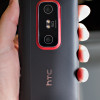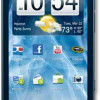Review: HTC EVO 3D
Screen
The EVO 3D shares the same qHD Super LCD that's found on HTC's Sensation 4G. It measures 4.3 inches and packs in 960 x 540 pixels. It looks excellent. It's bright, colors are rich, and graphics look razor-sharp. It's nearly impossible to pick out individual pixels. You have to break out a magnifying glass for that. HTC has done an excellent job choosing these Super LCD displays, and the EVO 3D's is among the best I've tested.
Signal
Hmm. First, WiMax performance. The 4G radio can find Sprint's WiMax network, but not very consistently. Using the phone in New York City on two separate occasions, it connected to the WiMax network lickety-split, held onto it for a minute, and then dropped it. I wasn't able to reconnect to the 4G network for several moments. The rest of the time I was in NYC, the signal waffled between 4G and 3G, as though it couldn't decide which network it preferred. Data speeds and browser performance were, understandably, inconsistent. When it was connected to WiMax, it was fast. When it wasn't, things slowed down.
As for 3G, out in NJ where 4G isn't live yet, I was able to spend a weekend with the EVO 3D using EVDO-only coverage. How well did this work? In a word: disaster. The EVO 3D barely held onto one bar most of the time. This led to missed calls, plenty of repeat dials, and several dropped calls. Not good. As for 3G data performance, it was better than voice performance for sure. Speeds were decent, and 3G browsing sessions were acceptably quick, even with only one bar. At my home in NJ, one bar is pretty typical for Sprint. It performed on par with other Sprint 3G devices.
Sound
Sound is a bit of a mixed bag with the EVO 3D. Earpiece volume is great. Phone calls are plenty loud in your ear, and border on painful when the volume is set to the max. A mid-level setting is appropriate for most environments. Call quality, however, wasn't so great. Voices were often garbled, making me ask those with whom I spoke to repeat themselves. The speakerphone was also capable of producing plenty of volume, but the garbled quality of calls were magnified here. Ringers and alert tones could be set to maddeningly loud volumes, and the vibrate alert was strong enough to make the EVO 3D dance across my desk.
Battery
HTC gave the EVO 3D's battery a significant boost over the original EVO 4G, increasing its capacity from 1500mAh to 1730mAh. Sprint said they believed that the increase would help squash the well-deserved complaints about the EVO 4G's battery life. While there is a definite improvement, the EVO 3D still does not have what I'd call "good" battery life. Where the EVO 4G barely lasted through lunch time, the EVO 3D at least makes it past 5PM consistently. Under WiMax coverage, it definitely died off in about 10 to 12 hours. In 3G-only coverage regions — with the WiMax radio turned off — the EVO 3D performed only marginally better. Ranging instead between 14 and 16 hours from full charge to dead. Bottom line: charge it every night, and make sure you have a USB cable handy at all times.


 Hands-On: HTC EVO 3D, Samsung Nexus S 4G
Hands-On: HTC EVO 3D, Samsung Nexus S 4G
 HTC EVO 3D Brings Stereoscopic Powers to Sprint
HTC EVO 3D Brings Stereoscopic Powers to Sprint
 HTC EVO V 4G / EVO 3D (CDMA)
HTC EVO V 4G / EVO 3D (CDMA)









